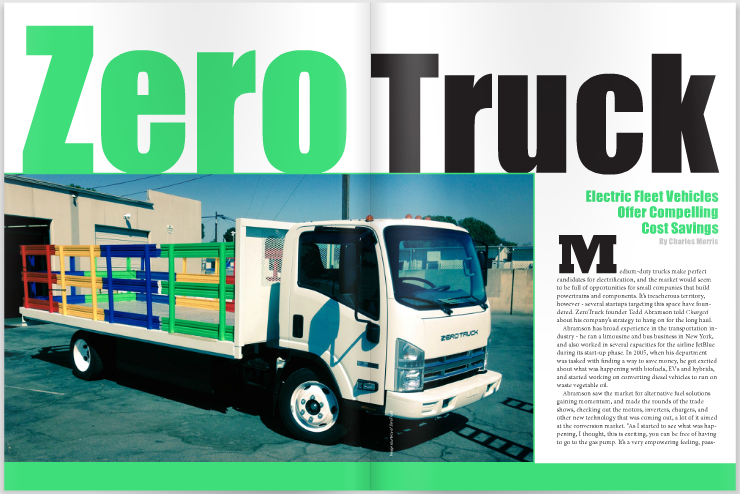Medium-duty trucks make perfect candidates for electrification, and the market would seem to be full of opportunities for small companies that build powertrains and components. It’s treacherous territory, however – several startups targeting this space have foundered. ZeroTruck founder Tedd Abramson told Charged about his company’s strategy to hang on for the long haul.
Abramson has broad experience in the transportation industry – he ran a limousine and bus business in New York, and also worked in several capacities for the airline JetBlue during its start-up phase. In 2005, when his department was tasked with finding a way to save money, he got excited about what was happening with biofuels, EVs and hybrids, and started working on converting diesel vehicles to run on waste vegetable oil.
Abramson saw the market for alternative fuel solutions gaining momentum, and made the rounds of the trade shows, checking out the motors, inverters, chargers, and other new technology that was coming out, a lot of it aimed at the conversion market. “As I started to see what was happening, I thought, this is exciting, you can be free of having to go to the gas pump. It’s a very empowering feeling, passing the gas station. I realized pretty quickly that it’s not sustainable for us to run on biofuels completely, because of the amount of fuel we use in this country, and I started digging deeper.”
After about three years of going to shows and asking questions, Abramson, as so many others have, concluded that electrification was the solution to the problems of dependence on foreign fuel, pollution and climate change.
Smith Electric Vehicles, a British company that was one of the pioneers in the electric-truck market, captured Abramson’s imagination, and he thoroughly investigated its Newton electric truck. In 2007, after meeting with Smith, it occurred to him that it would make more sense to build a similar vehicle on the well-established Isuzu platform, rather than importing a Czech vehicle to the US.
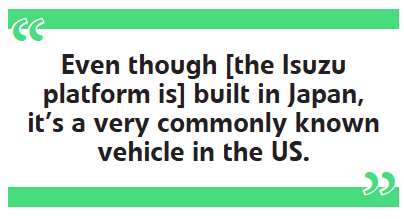
“Smith was bringing in a Czech cab, and I thought, why reinvent the wheel? Why not take the Isuzu product, and replace the engine and tranny with an electric motor and advanced lithium batteries? Even though it’s built in Japan, it’s a very commonly known vehicle in the US. At JetBlue and other companies, we had Isuzu trucks, and we knew that they were very reliable, and drivers liked them. Let’s take something that’s already known and electrify it.” That was the genesis of ZeroTruck, which opened in January 2008 in the Los Angeles suburb of Santa Ana.
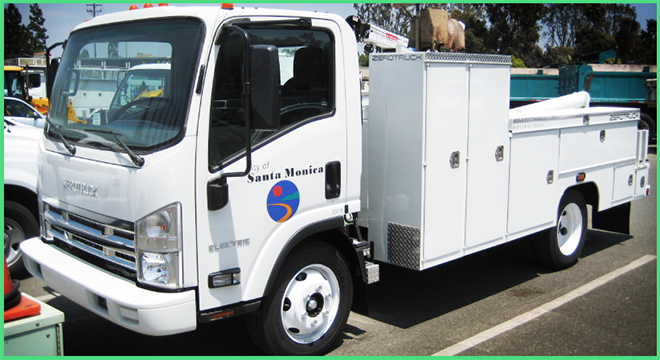
“We hired an engineering team to build us a prototype with a small lithium-ion battery pack, so we could test the market and see what the response would be. At an alternative fuels show in May 2008 in Las Vegas, which was one of the first shows where a lot of fleets from around the country met, there were no other electric truck companies there. We got cards from every state in the country, saying, ‘When you guys have a vehicle, we’d be interested.’”
With the first prototype truck on the road, ZeroTruck set about refining its product, engineering, optimizing and testing different platforms. “The big challenge at that time was that cost per kWh was about $1,400. The truck would never be affordable without substantial incentives, so our mission at that point was to find a battery solution that would get the cost down to about a six-year ROI. That would be something that fleet managers would be able to afford.”
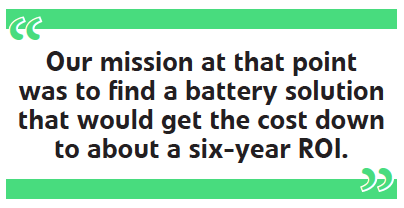
“At that first show we met Rick Sikes, Fleet Manager for the City of Santa Monica, and he said they’d like to get a truck with a service body for the Santa Monica fleet. They test a lot of vehicles, and are very open to new tech. The South Coast Air Quality Management District paid half the cost, and they ordered it in 2009. With all the paperwork, it took about 10 months to get the approval. We delivered that truck as a demonstrator vehicle in January 2010. It’s a 14,500-pound vehicle with a 3,000-pound hydraulic crane. It’s still running as we speak. They use it to change water valves.” At that same time, Abramson brought in a management team, and switched from CEO to CMO to focus on grants and sales.
Follow the money
In 2012, with the help of the non-profit technology consortium Electricore, ZeroTruck applied for and received a grant from the California Energy Commission to commercialize its platform. Subsidies were provided to offset the purchase price for California fleets, and by 2013, the company had sold 14 trucks under the program. California is the hottest market for electric trucks, but, with the help of state incentives, there’s also a lot of interest in New York, Texas, Washington and Oregon.
“In 2011, we were offered incentives to move to Pennsylvania, where the new CEO lived. With that funding we opened an 8,000-square-foot facility in Allentown – an old Mack truck plant – and stayed there about two years. However, the real traction and interest in electric trucks remained concentrated back West in California.” In December 2013, Abramson returned to the helm as CEO and moved the company back to Los Angeles.
The system
ZeroTruck’s Electric Drive Integration System (EDIS) features the company’s proprietary battery modules, which use lithium polymer cells. The liquid-cooled battery packs are offered in two sizes: 53 kWh, which yields a range of about 65 miles (on the UDDS cycle); and 80 kWh, which is designed for vehicles that will be running hydraulics or other accessories, and gives a range of up to 80 miles.
The motors come from UQM, and are offered in several configurations. Heavy-duty transmissions are available in single-speed, 3-speed and 6-speed versions. The system comes with a standard 3 kW charger, but that can be increased as high as 20 kW. Charging is Level 2 and 3, using the J1772 connector and DC Combo, with a CHAdeMO option under development. The company plans on testing Hevo Power’s wireless charging system as an optional charging solution once it receives UL approval, which is expected in early 2015. Vehicle-to-grid (V2G) capability is also planned as an option for 2015.
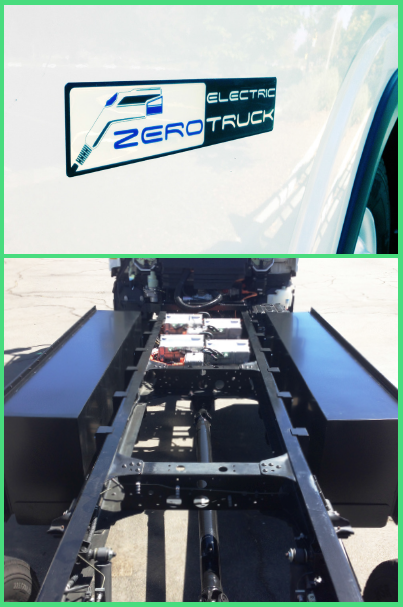
Why did ZeroTruck choose XALT Energy cells? “The original relationship was with Dassault of France, the aerospace company, Dow Chemical and Kokam of Korea. Kokam had some of the best results in reliability and efficiency of the cells, and they were already making large-format prismatic cells for quite a while. So we did a lot of testing, we looked at a lot of the papers, and we felt that the Kokam cells, which became Dow Kokam and now XALT, have the best energy density and stability of all the cells that fit into our package.”
Customer flex
ZeroTruck delivers all its vehicles through local dealers. “We work with the dealers because they have contact with the local customers. We train the dealer prior to delivery, so if something comes up on the truck the dealer can advise us. We also have telematics to be able to identify any technical issues.”
The company is talking with partners about expanding to international markets, especially Europe. “Isuzus are in every country, so they can just order the standard chassis, left-hand or right-hand drive, remove the engine, resell it, and then populate the truck with our EDIS. All of the wiring is standardized to be able to fit into the Isuzu platform. I wouldn’t say it’s exactly plug-and-play, but there’s a lot of plugging-in that gets done.”
While several other electric-truck companies are focusing on the delivery market, ZeroTruck is targeting cities and local government agencies. “We’ve identified that there are 88,000 municipalities in the US, and that’s a nice market to incorporate the electric truck, because generally they don’t go more than 40-50 miles a day, and they want flexibility. Some companies offer one or two options, but one reason we went with the Isuzu chassis is because every medium truck company makes something for it, so you have literally hundreds of body options. You have a lot of flexibility, which you don’t get if you have a purpose-built vehicle.”
The 12 vehicles currently being built include a refrigerated box truck and a bucket truck with a lift for signal light maintenance. “The city of Irvine is getting a service body truck, and we’re building some for Google that have a stake bed that they use to repair bicycles around the campus, so they have a zero-emission truck fixing zero-emission bicycles.”
Staying power
For commercial fleets, the cost savings from going electric are compelling, so why have so many companies targeting this market (including several profiled in Charged) gone out of business? As Abramson sees it, the potential is huge, but the industry moves slowly, and most startups aren’t prepared to hang on for the years it may take for profits to appear.
“I learned from the airline industry, you have to keep your costs in line with your growth. I feel bad for all the players that have tried to make it and aren’t here any longer, but it’s very difficult to explain to investors that this is going to be a slowly moving market. It’s a solid market, the demand is there. We don’t have to struggle to get orders – the trucks sell themselves. But the biggest challenge is that investors don’t understand that, yes it’s the future for fleets that are going under 100 miles per day, but it’s still going to be a few years before costs go down and profits go up.
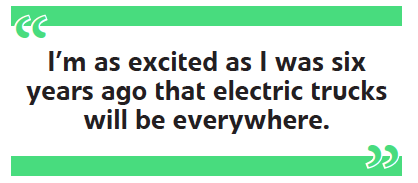
“We constantly look to improve on the product, we look for ways to lower the cost, we look for ways to partner with other companies that are going in the same direction, and try to be realistic about opportunities versus how much you’re going to expand. It’s a capital-intensive business – you have to be really conservative with your overhead while you’re trying to drive the cost down, but I’m as excited as I was six years ago that electric trucks will be everywhere, eliminating pollution and reducing petroleum use for fleets. If you look at the whole picture, it makes perfect sense.”
Abramson calculates that the ROI period for ZeroTrucks is 3.5 to 5.5 years, not counting any government subsidies, for a fleet operator with service routes of up to 70 miles per day. That’s an attractive proposition, and it’s getting even better, as upfront costs continue to go down. “Since 2008, we’ve seen the price for battery packs go from $1,400 per kWh to the $500-600 range (with US cells, not Chinese). It’s quite a drop.”
Cell manufacturers are under a lot of pressure to reduce prices. “That’s a business I would not want to be in – you may have the next greatest thing in your lab, but somewhere across the country or across the globe, somebody will unseat you with a better battery, and that’s just the way it is. But when you get to the right combination of energy density and the ability to make these things reliably, you’re going to have a lot of customers knocking on your door.”
This article originally appeared in Charged Issue 16 –November/December 2014




